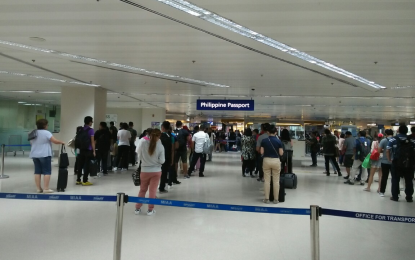
(File photo)
MANILA – Malacañang on Saturday night said the Inter-Agency Task Force for the Management of Emerging Infectious Diseases (IATF-EID) has approved the retroactive application of the testing and quarantine protocols for qualified travelers who arrived in the country on or before Jan. 13.
"In a resolution issued by the IATF on Saturday, January 15, testing and quarantine protocols for Green and Yellow List countries/territories/jurisdictions per IATF Resolution No. 157 shall now apply to those who arrived in all ports of entry in the Philippines on or before Jan. 13, 2022," acting presidential spokesperson and Cabinet Secretary Karlo Nograles said in a statement.
Nograles said the IATF-EID has also directed the implementing agencies "to ensure the smooth and proper implementation of these protocols intended to screen Filipinos and foreign nationals entering the country from abroad."
“Also, the IATF clarified that foreign nationals coming from ‘red list countries’ and allowed admission in the country under existing IATF rules may enter the Philippines provided they have valid or existing visas,” Nograles said.
The IATF, he added, also stressed that their entry is subject to Philippine immigration laws, rules, and regulations.
On Friday, Nograles said the government has lifted the entry ban on Filipino travelers coming from countries placed under the "red list" from Jan. 16 to 31.
The countries placed under the red list are Antigua and Barbuda, Aruba, Canada, Curacao, French Guiana, Iceland, Malta, Mayotte, Mozambique, Puerto Rico, Saudi Arabia, Somalia, Spain, and US Virgin Islands.
"Napagdesisyonan na kahit sa red list countries na mga Filipinos (It was decided that Filipinos, even if they come from red list countries), we will now allow them to come in as long as they comply with the red list protocols. Hindi na kailangan maghintay ng (No need to wait for) Bayanihan flights from these countries," he said in a Palace briefing.
Previously, only Filipinos from red list countries returning via Bayanihan flights or repatriation efforts are exempted from the travel ban.
However, the country's borders remain closed to foreign tourists from “red list” countries.
Nograles said fully vaccinated travelers coming from the red list countries shall be required to present a negative reverse transcription-polymerase chain reaction (RT-PCR) Covid-19 test 48 hours before departure from the country of origin; undergo a facility-based quarantine with an RT-PCR Covid-19 test on the seventh day; and complete home quarantine up to the 14th day from their arrival to the Philippines once they get a negative result.
Nograles, meanwhile, said travelers who are unvaccinated, partially vaccinated, or individuals whose vaccination status cannot be independently validated shall be required to present a negative RT-PCR test taken within 48 hours before departure from the country of origin; and undergo a facility-based quarantine with an RT-PCR Covid-19 test on the seventh day.
They may be discharged only upon the completion of a 10-day facility-based quarantine, regardless of a negative RT-PCR result, and shall be required to undergo home quarantine until the 14th day from their arrival in the Philippines.
Meanwhile, placed under green list from Jan. 16 to 31 are Bangladesh, Benin, Bhutan, British Virgin Islands, China, Cote d' Ivoire, Djibouti, Equatorial Guinea, Falkland Islands, The Gambia, Ghana, Guinea, Hong Kong, India, Indonesia, Japan, Kosovo, Kyrgyzstan, Montserrat, Morocco, Niger, Oman, Pakistan, Paraguay, Saba (Special Municipality of the Kingdom of the Netherlands), Saint Barthelemy, Senegal, Sierra Leone, Sint Eustatius, Taiwan, Timor-Leste, and Uganda.
All countries and territories not included in either green or red list are placed on the yellow list. Under the classification drawn up by the IATF-EID, green list countries are those considered as “low risk” for Covid-19, yellow list countries are those with “moderate risk”, while red list countries are deemed as “high risk”. (PNA)
